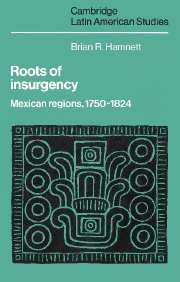Book contents
- Frontmatter
- Contents
- List of maps
- Acknowledgements
- Weights and measures
- Map 1 The viceroyalty of New Spain in 1810
- Introduction
- 1 Social tensions in the provinces
- 2 Insurgency — characteristics and responses
- 3 Conflict, protest and rebellion
- 4 Dearth and dislocation
- 5 Insurrection — recruitment and extension
- 6 The struggle for Puebla,1811–13
- 7 Local conflict and provincial chieftains
- 8 Conclusion
- Notes
- Bibliography
- Index
- CAMBRIDGE LATIN AMERICAN STUDIES
1 - Social tensions in the provinces
Published online by Cambridge University Press: 20 October 2009
- Frontmatter
- Contents
- List of maps
- Acknowledgements
- Weights and measures
- Map 1 The viceroyalty of New Spain in 1810
- Introduction
- 1 Social tensions in the provinces
- 2 Insurgency — characteristics and responses
- 3 Conflict, protest and rebellion
- 4 Dearth and dislocation
- 5 Insurrection — recruitment and extension
- 6 The struggle for Puebla,1811–13
- 7 Local conflict and provincial chieftains
- 8 Conclusion
- Notes
- Bibliography
- Index
- CAMBRIDGE LATIN AMERICAN STUDIES
Summary
A profounder meaning of events lies perhaps beneath the ideological superstructure of a movement of Independence. To discover this meaning we must examine attitudes and alignments at the provincial level. The provinces of Puebla, Guadalajara, Michoacán and Guanajuato clearly illustrate the uneven development of Mexico in the late colonial and early national period. With their regional and sub-regional variations, these provinces provide a feasible basis for comparison and contrast. Furthermore, each of them, at one stage or another, became a major theatre of operations during the War of Independence between 1810 and 1821. When it becomes appropriate to do so, in order to develop the themes that are central to the book, case instances from a number of other, usually contiguous, provinces, namely San Luis Potosí, Zacatecas, Veracruz and Oaxaca, will be given. In view of this strictly provincial approach to the late colonial and independence period, attention will not focus here upon the national level of policial economic life. The intention is to examine certain specific themes, which are essential for a proper comprehension of the Independence movement as an expression of regional social tensions. Where documentary evidence permits, the discussion will move beyond the ‘Mexican or resident’ élite of merchant-investors, mine-operators, municipal councillors and landowners and the “provincial bourgeoisie” of lawyers, clerics, intellectuals, writers, doctors, to the social strata beneath them. These were by no means homogeneous and in terms of social stratification are often difficult to place. Where exactly we place shopkeepers in the social structure is a virtually irresolvable problem, since this frequently neglected occupational group contained a broad spectrum all of its own.
- Type
- Chapter
- Information
- Roots of InsurgencyMexican Regions, 1750–1824, pp. 24 - 46Publisher: Cambridge University PressPrint publication year: 1986



